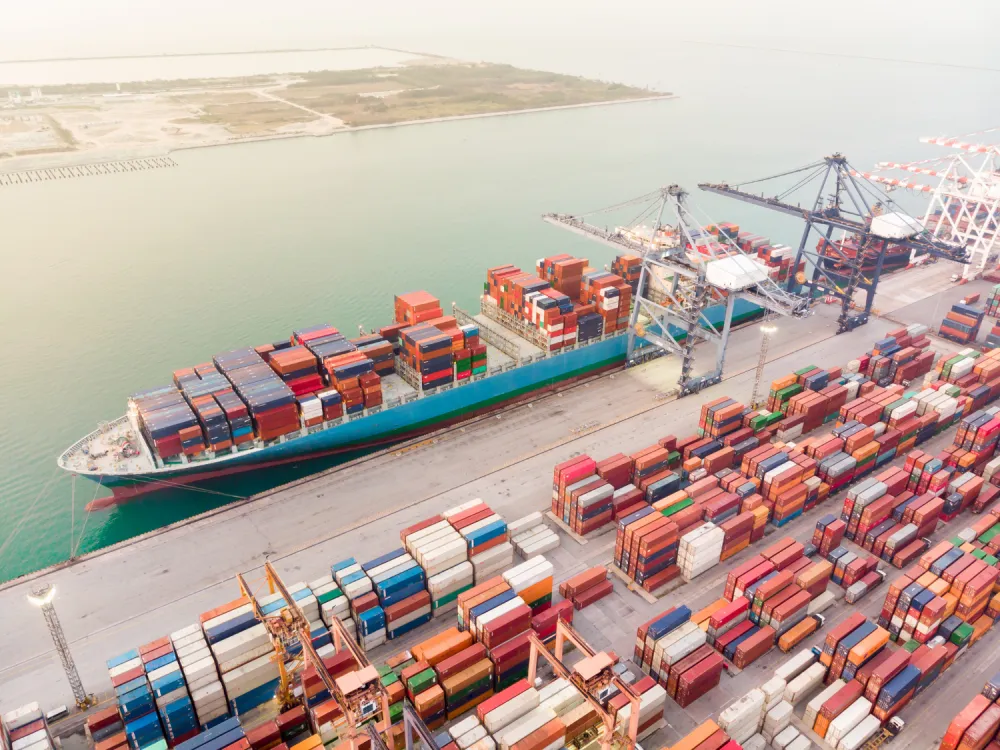
Port with cargo ships and containers to signify trade.
International Trade Theories: A Closer Look at Import and Export Models
International trade is a fundamental driver of global economic dynamics, playing a crucial role in the growth and expansion strategies of businesses worldwide. This article provides an in-depth analysis of the predominant import and export models that form the backbone of international trade theory and practice.
Understanding these models is vital for British business owners who operate in the complex global marketplace, as they offer insights into efficient trade practices and decision-making processes.
Comparative Advantage: The Bedrock of Trade Efficiency
The principle of comparative advantage, also known as the Ricardian model, was developed by David Ricardo in the early 19th century and is one of the earliest and most influential import and export models. It posits that nations should specialise in producing goods for which they have a lower opportunity cost compared to other nations. This specialisation enables countries to trade effectively, ensuring that resources are optimally utilised globally. For businesses, understanding comparative advantage is crucial in making strategic decisions about which goods to import or export, thus maximising profitability and competitiveness. For example, a UK audio equipment firm, capitalising on the country's expertise in technology and skilled labour, exports top-quality speakers and sound systems globally. To lower production costs and enhance product competitiveness, it imports cost-effective basic electronic components, like resistors and capacitors, from countries where production is cheaper. Moreover, the ease of shipping goods abroad has significantly increased, thanks to freight forwarding businesses. These firms arrange diverse transport options, including sea, rail, and road freight, and manage pallet delivery at both ends, streamlining the international trade process
Absolute Advantage: Understanding Trade Dynamics
Absolute advantage, a concept developed by Adam Smith, refers to a country's ability to produce a certain good more efficiently than other countries. Unlike comparative advantage, which focuses on relative efficiency, absolute advantage looks at absolute productivity. Businesses considering international trade must evaluate their own absolute advantages or those of their suppliers to optimise their import-export strategies and enhance supply chain efficiency.
The Heckscher-Ohlin Model: Factor Endowments and Trade Patterns
The Heckscher-Ohlin model, developed by Eli Heckscher and Bertil Ohlin in the early 20th century, builds on the Ricardian model by introducing the concept of factor proportions. The model provides a deeper understanding of how differences in factor endowments, like labour and capital, influence trade patterns. It suggests that countries will export goods that intensively use their abundant factors and import goods that require factors in relative scarcity. For British businesses, this model highlights the importance of considering domestic factor endowments when determining export strategies and sourcing imports.
The Gravity Model of Trade: Economic Size and Distance
The Gravity Model uses the analogy of gravitational pull to explain trade flows, suggesting that larger economies have a greater 'pull' in terms of attracting trade, while distance acts as a deterrent. The gravity model is based on the intuition that trade flows are more likely to occur between countries that are economically similar and geographically close. This is because countries that are similar in size and income level tend to have more complementary economies, which means that they produce goods and services that are different enough to be traded but similar enough to be compatible with each other's consumption patterns.
New Trade Theory: Economies of Scale and Market Imperfections
The New Trade Theory, which incorporates elements of economies of scale and monopolistic competition, offers insights into how market imperfections and economies of scale influence international trade. This theory is instrumental for businesses in understanding the competitive landscape of global markets and in identifying opportunities for scaling up production for export purposes.
Applications of Import and Export Models
Import and export models are instrumental tools in the arsenal of economists and policymakers, serving to unravel and analyse the multifaceted aspects of international trade. One key application of these models is in assessing the impact of trade policies, such as tariffs and quotas. These policies can significantly alter trade flows and, consequently, the national welfare of countries involved in trade. By applying these models, analysts can predict changes in market dynamics and guide policy decisions to optimise economic outcomes.
Another critical area where these models prove invaluable is in understanding the determinants of comparative advantage and the resulting pattern of international trade. They help in identifying sectors where nations hold a competitive edge, thereby informing strategic decisions about where to allocate resources and efforts.
Limitations of Import and Export Models
Despite their utility, it's crucial to recognise the limitations of import and export models. These models typically assume perfect competition, an idealised scenario that often diverges from the more complex and imperfect real-world markets. This assumption can lead to oversimplified conclusions that may not fully account for the nuances of actual trade dynamics.
Moreover, these models tend to overlook other critical factors such as transportation costs, government interventions, and various market imperfections. These elements can have a profound impact on trade, influencing everything from the feasibility of exporting certain goods to the competitive landscape of global markets.
Despite these limitations, import and export models remain fundamental in providing valuable insights into the determinants and consequences of international trade. While acknowledging their constraints, it is essential to leverage these models for their ability to shed light on the intricate workings of international commerce, guiding businesses and governments in navigating the ever-evolving landscape of global trade.
Conclusion
The theories and models of international trade provide a framework for understanding the complex dynamics of global commerce.
By comprehensively understanding and applying these models, businesses can enhance their competitive edge, optimise their operations, and successfully navigate the challenges and opportunities of international trade. As the global economic landscape continues to evolve, staying abreast of these theories and their practical applications remains essential for businesses aiming to thrive in the international marketplace.


